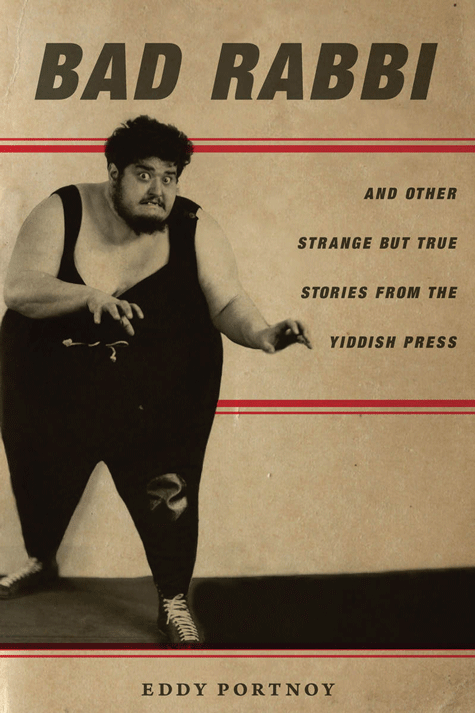Reviewed by NEAL GENDLER
Eddy Portnoy’s charming collection of strange Jewish news stories begins by describing an all-but-vanished press that enlightened and entertained a now-vanished nation: Yiddishland.

“A century or so ago … the Jews of Eastern Europe and their diasporas were most definitely a nation,” Portnoy says in Bad Rabbi. “They lived in Yiddishland” with their own culture, foods, folktales, music and literature, “all carried by their own language, Yiddish.”
Yiddishland disappeared from North America as immigrants and their children adopted English, from Europe with Nazi murder and Communist suffocation, and from Israel, where it was disparaged as the language of weakness and exile.
Think of it in my mother’s family’s rather literal term, “speaking Jewish,” and it’s as though someone else’s national language, perhaps Danish or Dutch, has all but disappeared.
Now, although taught in some places, few but those labeled “ultra-Orthodox” conduct their lives speaking Jewish.
“The national sport of Yiddishland was journalism,” says Portnoy, senior researcher and exhibitions director at YIVO Institute for Jewish Research. His 24-page introduction calls Yiddish newspapers “the king of all Jewish media” from the 1880s through the 1930s. They catered to “virtually every political and social orientation,” cramming together news, advertising, literature, poetry, political arguments and the meat for Bad Rabbi, scandal, crime and tragedy.
That press “transformed Jewish life, hooking readers like fish and reeling them in the direction of the modern world,” Portnoy says. Early efforts were weak, but as pogroms drove millions of Jews from Russia – which until 1918 included Poland –the Yiddish press exploded. New York City became the world’s largest Yiddish-speaking diaspora.
After the failed 1905 Russian revolution, a Yiddish press modeled after New York’s flourished in Eastern Europe.
“Millions of crumbling, yellowed newspaper pages disintegrating in archives and on library shelves” contain “bizarre and improbable situations…products of the concrete jungles that migrating Jews fell into during the late 19th and early 20th centuries,” he says. It’s “the largest chronicle of Jewish daily life ever assembled.”
Like many books from college publishing houses, but far more entertaining than most, Bad Rabbi grew from a doctoral dissertation, Portnoy’s on Yiddish press cartoons. In umpteen hours of reeling through microfilm, Portnoy accidentally printed a wrong page. He saw a headline: “Two Wives, Blazing Punches — the Cops.” The women had gone to rabbinical court — along with family members who began a post-verdict brawl.
“I had never come across Jews like these … the crass, uneducated rabble who populated impoverished Jewish ghettos in both the Old World and the New.”
That story — Chapter 14 — shows a side of Jewish life seldom appearing in rose-tinted Yiddishland memories, but Yiddish newspapers were full of them. Chapter 9 describes a bris leading to a brawl among witnesses loyal to different rebbes. We learn of the life of would-be prophet Naftali Herz Imber, writer, alcoholic and poet who wrote the words to Hatikva, and of “The Great Tonsil Riot of 1906,” following a rumor that surgeons were slashing schoolchildren’s throats.
“Attack of the Yiddish Journalists,” displays fierce newspaper competition — a battle of vicious insults after popular columnist Hillel Tseytlen left one paper for another.
Chapter 11 unmasks Israel Joshua Singer, older brother of Nobel Prize winner Isaac Bashevis Singer, writing for the Yiddish press as Gimel Kuper to protect his literary reputation. I.J., “widely regarded as one of the greatest Yiddish novelists of the 20th century,” died young, little lauded outside Yiddishland, Portnoy says.
Both Singers mined Warsaw’s rich rabbinic divorce court for stories read avidly — as were the “police blotter” reports.
Many of these chapters appeared earlier in magazines, particularly “Tablet,” and some have been expanded for the book, which includes illustrations, cartoons and photos – especially good for the chapter on a 1929 Polish “Miss Judea Peageant” and its consequences.
Portnoy says that most people know more about how Eastern European Jewry ended than about how it lived, and understanding Yiddishland’s “rich and diverse culture … requires a more-complex perspective than looking at Jews only as victims and survivors of genocide.”
***
Neal Gendler is a Minneapolis writer and editor.
(American Jewish World, 12.29.17)



















